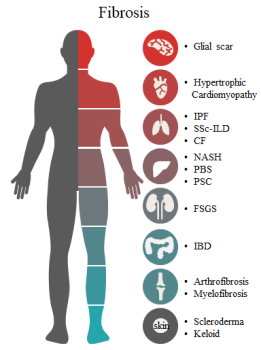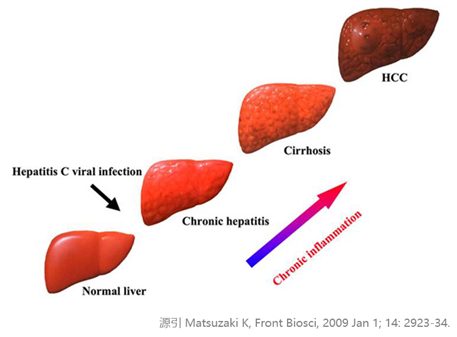Fibrosis
Fibrosis is characterized by the formation an excessive fibrous connective tissue and deposition of extracellular matrix by fibroblasts, with progressive architectural tissue remodeling at the site of injury or inflammatory lesions and surrounding areas.Fibrosis

can occur in a variety of tissues and organs, especially important functional organs (the liver, lung, kidney and heart). This process is often irreversible and progressively aggravated, severely damages organ structure, and leads to organ dysfunction and failure, which greatly reduces the quality of life in patients and seriously threatens human health. Statistics show that 45% of people who die from various diseases can be attributed to fibrosis. This is also the final pathological outcome of common chronic inflammatory diseases such as scleroderma, rheumatoid arthritis, Crohn's disease, ulcerative colitis, Myelofibrosis and systemic lupus erythematosus, etc. Although collagen deposition is a typical, reversible and normal essential phenomenon to wound healing, with the excessive damage of tissue, normal tissue repair can evolve into an irreversible fibrotic response. At the same time. it also affects the invasion and metastasis of tumors, chronic graft rejection and progressive myopathy.
The occurrence of fibrosis involves inflammatory response, oxidative stress, immune response, and occurrence-related varieties of cytokines and signaling pathways. The complexity of the mechanism of fibrosis poses a great challenge to pharmaceutical development, which makes the treatment progress slow in this field. With in-depth research of the mechanism related to fibrosis diseases in recent years, based on the molecular mechanisms of multiple cytokines and their activated intracellular signaling pathways involved in fibrosis occurrence, the main nodes in these signaling pathways have become the main target for the drugs for prevention and treatment of fibrosis on a global scale.
Idiopathic pulmonary fibrosis
Idiopathic pulmonary fibrosis (IPF) is a chronic, progressive, fibrotic interstitial lung disease with an unknown cause, characterized by progressive lung scarring and the histologic pattern of usual interstitial pneumonia (UIP),

and affects alveolar and surrounding tissues with lung tissue gradually thickening, stiffening and permanent scar formation, which makes it difficult for the lungs to transport oxygen to the blood, and the patient eventually develops progressive dyspnea until respiratory failure and death.Globally, the incidence of ILD and especially that of Idiopathic Pulmonary Fibrosis (IPF) is rising sharply with age and is conservatively estimated to be 3-9 people per 100,000 per year. The prognosis of IPF patients is poor, with the average survival time being only 3-5 years after diagnosis. Generally, about two-thirds of patients with IPF die within 5 years according to previous studies from Western countries. There is currently no effective treatment for this fatal disease, which has a higher mortality rate than most tumors and is called a “tumor-like disease”.Currently, The antifibrotic agents pirfenidone (Esbriet, Roche) and Nintedanib (Ofev, Boehringer Ingelheim) are approved drugs for the treatment of IPF, both of which are conditionally recommended in the international guidelines for IPF. The use of the two antifibrotic drugs, far from meeting the needs of clinical application and market demand, slows down the decline of lung function and improves outcome, but does not completely stop further deterioration.
Liver fibrosis

Liver fibrosis is the pathological feature of most chronic liver diseases, which is caused by chronic liver injury and excessive deposition of extracellular matrix. Excessive deposition of extracellular matrix can lead to fibrous scarring and abnormal changes in liver tissue structure, and eventually form cirrhosis. Cirrhosis not only increases the resistance of the liver to blood flow and form portal hypertension but also cause the dysfunction of liver cells and lead to liver failure, even liver cancer, which seriously affects human health and quality of life. Chronic liver diseases mainly include all kinds of liver diseases with a disease duration of more than six months caused by viral hepatitis, chronic alcoholic liver disease, non-alcoholic fatty liver disease, drug-induced liver injury, auto-immune liver disease, and genetic metabolic liver disease, etc. Most chronic liver diseases can be effectively treated by preventing or delaying the progression of liver fibrosis. However, due to the complex pathological mechanism and diverse etiology of liver fibrosis, the difficulty of drug research and development is aggravated. Therefore, there is no effective drug available for clinical application at present.





